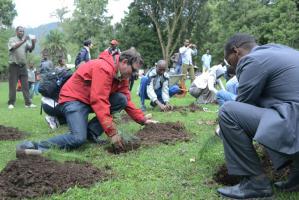BY ANDUALEM SISAY GESSESSE –
The World Bank (WB) on Friday launched a ten years program in Ethiopia that enables the country to reduce its carbon emissions from deforestation. The program among others targets helping the country to make money from global carbon trading by using its forests for absorbing carbon emissions.
The $18 million grant for the project is provided by the WB’s BioCarbon Fund (Initiative for Sustainable Forest Landscapes) financed by donors such as, Norwegian and United States governments.
“The grant supports community-centered activities that reduce deforestation and land-use based emissions as well as enhances forest carbon stocks in deforestation hotspots in selected sites in 49 districts of Oromia Region,” said Tesfaye Gonfa, coordinator of Oromia Forested Landscape Program. he made the remark speaking at the launching ceremony 80 kilometers from Addis Ababa in Ginchi town, where 5,000 hectares of mountains are covered with forest.
The project will enable Ethiopia to manage properly its depleting forests and protect from deforestation and reduce carbon emission. Deforestation in Ethiopia is the major contributor of carbon emission followed by livestock, according to Stephen Danyo, Senior natural resources management specialist at the World Bank.
It is estimated that Ethiopia emits 19 million tons of carbon as a result of deforestation while it absorbs close to 5 million tons of carbon through afforestation (planting trees).
“As a nation, our forest is a net emitter of around 14 million tons of carbon,” Yitebitu Moges (PhD), coordinator of National REDD+ at Ethiopian Ministry of Environment , Forest and Climate Change, told NATION Correspondent in Ethiopia.
REDD+ stands for reducing emissions from deforestation and forest degradation in developing countries, and the role of conservation, sustainable management of forests, and enhancement of forest carbon
stocks in developing countries.
The total forest coverage area of Ethiopia at the moment is 15.5%, according to Dr. Yitebitu who noted that Ethiopia one of the four countries in the world selected for WB’s program along with Cambodia, Indonesia, Zambia and Ethiopia.
“Today we have taken important action for the sustainability of overall production systems including support for agriculture, energy, water and support for reducing poverty in general, “ Mr. Danyo said, indicating that the $18 million grant is for five year to kick start the ten year project.
If properly implemented the project in the coming years and able to cut carbon emissions of Ethiopia from its forestry, additional $50 million grant will be provided to the Oromia Region by the WB. “Our plan is to provide 80% of the $50 million grant for the community that manages and protects these forests,” says Mr. Tesfaye, indicating that Oromia Region only loses annually 38,500 hectares of forest due to deforestation with 5,300 hectare of new forests (afforestation).
Oromia Region currently emits 5 million tons of carbon due to deforestation annually while absorbing 777,000 tons of carbon, according to Tesfaye who says that expansion of big farms and energy demand of the rural community are the main contributors of deforestation.
At national level Ethiopian government ambitiously targets to restore nine million hectares of forest of the country under such programs by the five years development plan began last year (in the four years period). “I think we can at least achieve half of our target,” Dr. Yitebitu hopes.
By the year 2030, Ethiopia targets to become a zero carbon emitting middle income nation. It is envisaged that after 13 years half of the total carbon Ethiopia emits will be absorbed by its existing and new forests. Including from industries, currently Ethiopia in total is emitting a total of 150 million tons of carbon.

